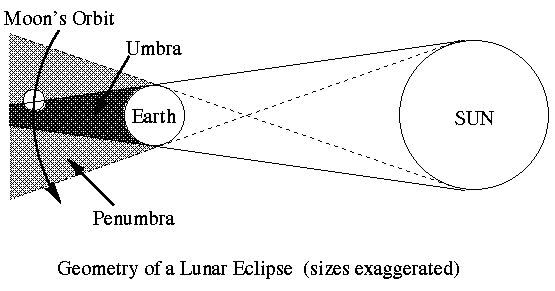
Our assumption that the Sun is infinitely far away such that the Earth produces a cylindrical shadow region, through which the Moon passes, is somewhat over simplified. We can see that things are more complicated because during a lunar eclipse there is actually a region of partial shadow, called the penumbra, surrounding the umbra, the region of complete shadow. If you were on the Moon during a lunar eclipse you would first notice that part of the Sun is blocked off by the Earth, this is when the Moon is in the penumbra of the Earth and terrestial observers would see the Moon starting to get darker. When the Moon passes into the umbra of the Earth, it goes into complete shadow and on the Moon you would not see the Sun at all, it would be completely blocked off by the Earth. What we measured in the lab was the relative size of the umbra which is actually quite a bit smaller that the relative size of the Earth itself. The reason it is smaller is because the region of total shadow behind the Earth is actually a tapering cone as opposed to a perfect cylinder. The fact that Sun appears as a disk in the sky tells us already that it cannot be infinitely far away and results in the tapering conical region of total shadow surrounded by a region of partial shadow.

The relative size of the umbra to the size of the Moon that we expect when taking this effect into account is actually about 2.9. So you see that the measurements you have made are not as bad as they may at first have seemed. The problem in this case was an over simplistic model of the lunar eclipse as opposed to problems with the measurements.